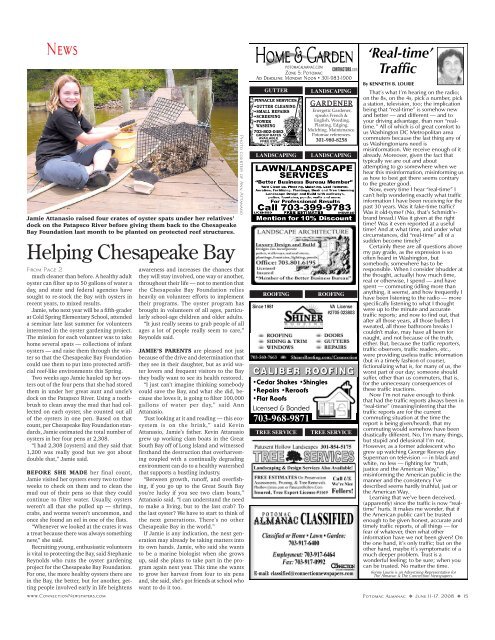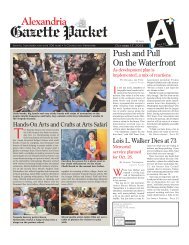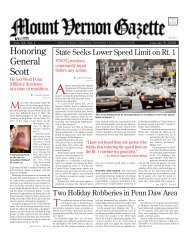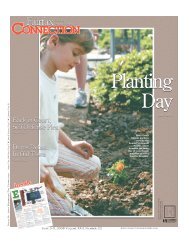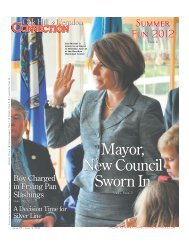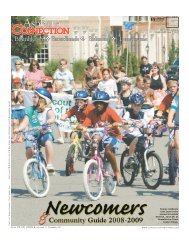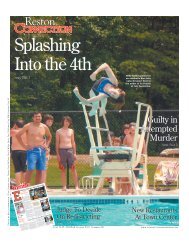Potomac - The Connection Newspapers
Potomac - The Connection Newspapers
Potomac - The Connection Newspapers
Create successful ePaper yourself
Turn your PDF publications into a flip-book with our unique Google optimized e-Paper software.
News<br />
Jamie Attanasio raised four crates of oyster spats under her relatives’<br />
dock on the Patapsco River before giving them back to the Chesapeake<br />
Bay Foundation last month to be planted on protected reef structures.<br />
Helping Chesapeake Bay<br />
From Page 2<br />
much cleaner than before. A healthy adult<br />
oyster can filter up to 50 gallons of water a<br />
day, and state and federal agencies have<br />
sought to re-stock the Bay with oysters in<br />
recent years, to mixed results.<br />
Jamie, who next year will be a fifth-grader<br />
at Cold Spring Elementary School, attended<br />
a seminar late last summer for volunteers<br />
interested in the oyster gardening project.<br />
<strong>The</strong> mission for each volunteer was to take<br />
home several spats — collections of infant<br />
oysters — and raise them through the winter<br />
so that the Chesapeake Bay Foundation<br />
could use them to put into protected artificial<br />
reef-like environments this Spring.<br />
Two weeks ago Jamie hauled up her oysters<br />
out of the four pens that she had stored<br />
them in under her great aunt and uncle’s<br />
dock on the Patapsco River. Using a toothbrush<br />
to clean away the mud that had collected<br />
on each oyster, she counted out all<br />
of the oysters in one pen. Based on that<br />
count, per Chesapeake Bay Foundation standards,<br />
Jamie estimated the total number of<br />
oysters in her four pens at 2,308.<br />
“I had 2,308 [oysters] and they said that<br />
1,200 was really good but we got about<br />
double that,” Jamie said.<br />
BEFORE SHE MADE her final count,<br />
Jamie visited her oysters every two to three<br />
weeks to check on them and to clean the<br />
mud out of their pens so that they could<br />
continue to filter water. Usually, oysters<br />
weren’t all that she pulled up — shrimp,<br />
crabs, and worms weren’t uncommon, and<br />
once she found an eel in one of the flats.<br />
“Whenever we looked at the crates it was<br />
a treat because there was always something<br />
new,” she said.<br />
Recruiting young, enthusiastic volunteers<br />
is vital to protecting the Bay, said Stephanie<br />
Reynolds who runs the oyster gardening<br />
project for the Chesapeake Bay Foundation.<br />
For one, the more healthy oysters there are<br />
in the Bay, the better, but for another, getting<br />
people involved early in life heightens<br />
www.<strong>Connection</strong><strong>Newspapers</strong>.com<br />
awareness and increases the chances that<br />
they will stay involved, one way or another,<br />
throughout their life — not to mention that<br />
the Chesapeake Bay Foundation relies<br />
heavily on volunteer efforts to implement<br />
their programs. <strong>The</strong> oyster program has<br />
brought in volunteers of all ages, particularly<br />
school-age children and older adults.<br />
“It just really seems to grab people of all<br />
ages a lot of people really seem to care,”<br />
Reynolds said.<br />
JAMIE’S PARENTS are pleased not just<br />
because of the drive and determination that<br />
they see in their daughter, but as avid water<br />
lovers and frequent visitors to the Bay<br />
they badly want to see its health restored.<br />
“I just can’t imagine thinking somebody<br />
could save the Bay, and what she did, because<br />
she loves it, is going to filter 100,000<br />
gallons of water per day,” said Ann<br />
Attanasio.<br />
“Just looking at it and reading — this ecosystem<br />
is on the brink,” said Kevin<br />
Attanasio, Jamie’s father. Kevin Attanasio<br />
grew up working clam boats in the Great<br />
South Bay off of Long Island and witnessed<br />
firsthand the destruction that overharvesting<br />
coupled with a continually degrading<br />
environment can do to a healthy watershed<br />
that supports a bustling industry.<br />
“Between growth, runoff, and overfishing,<br />
if you go up to the Great South Bay<br />
you’re lucky if you see two clam boats,”<br />
Attanasio said. “I can understand the need<br />
to make a living, but to the last crab? To<br />
the last oyster? We have to start to think of<br />
the next generations. <strong>The</strong>re’s no other<br />
Chesapeake Bay in the world.”<br />
If Jamie is any indication, the next generation<br />
may already be taking matters into<br />
its own hands. Jamie, who said she wants<br />
to be a marine biologist when she grows<br />
up, said she plans to take part in the program<br />
again next year. This time she wants<br />
to grow her harvest from four to six pens<br />
and, she said, she’s got friends at school who<br />
want to do it too.<br />
Photo courtesy of Ann Attanasio<br />
Home & Garden<br />
potomacalmanac.com<br />
CONTRACTORS.com<br />
Zone 5: <strong>Potomac</strong><br />
Ad Deadline: Monday Noon • 301-983-1900<br />
GUTTER<br />
PINNACLE SERVICES,<br />
•GUTTER CLEANING<br />
•SMALL REPAIRS<br />
•SCREENING<br />
•POWER<br />
WASHING<br />
703-802-0483<br />
GROUP RATES<br />
AVAILABLE<br />
FREE EST<br />
LANDSCAPING LANDSCAPING<br />
ROOFING ROOFING<br />
Since 1981 VA License<br />
#2705 023803<br />
CALIBER ROOFING<br />
•Cedar Shakes •Shingles<br />
•Repairs •Reroofs<br />
•Flat Roofs<br />
Licensed & Bonded<br />
703-968-9871<br />
LANDSCAPING<br />
GARDENER<br />
Energetic Gardener,<br />
speaks French &<br />
English. Weeding.<br />
Planting. Edging.<br />
Mulching. Maintenance.<br />
<strong>Potomac</strong> references.<br />
301-980-8258<br />
TREE SERVICE TREE SERVICE<br />
E-mail: classified@connectionnewspapers.com<br />
‘Real-time’<br />
Traffic<br />
By KENNETH B. LOURIE<br />
That’s what I’m hearing on the radio;<br />
on the 8s, on the 4s, pick a number, pick<br />
a station, television, too; the implication<br />
being that “real-time” is somehow new<br />
and better — and different — and to<br />
your driving advantage, than non “realtime.”<br />
All of which is of great comfort to<br />
us Washington DC Metropolitan area<br />
commuters because the last thing any of<br />
us Washingtonians need is<br />
misinformation. We receive enough of it<br />
already. Moreover, given the fact that<br />
typically we are out and about<br />
attempting to go somewhere when we<br />
hear this misinformation, misinforming us<br />
as how to best get there seems contrary<br />
to the greater good.<br />
Now, every time I hear “real-time” I<br />
can’t help wondering exactly what traffic<br />
information I have been receiving for the<br />
past 30 years. Was it fake-time traffic?<br />
Was it old-tyme? (No, that’s Schmidt’sbrand<br />
bread.) Was it given at the right<br />
time? Was it even reported at a useful<br />
time? And at what time, and under what<br />
circumstances, did “real-time” all of a<br />
sudden become timely?<br />
Certainly these are all questions above<br />
my pay grade, as the expression is so<br />
often heard in Washington, but<br />
somebody, somewhere has to be<br />
responsible. When I consider (shudder at<br />
the thought, actually) how much time,<br />
real or otherwise, I spend — and have<br />
spent — commuting (idling more than<br />
anything, it seems), and how frequently I<br />
have been listening to the radio — more<br />
specifically listening to what I thought<br />
were up to the minute and accurate<br />
traffic reports; and now to find out, that<br />
after all those years, all those bullets I<br />
sweated, all those bathroom breaks I<br />
couldn’t make, may have all been for<br />
naught, and not because of the truth,<br />
either. But, because the traffic reporters,<br />
traffic observers, traffic readers, etc.,<br />
were providing useless traffic information<br />
(but in a timely fashion of course),<br />
fictionalizing what is, for many of us, the<br />
worst part of our day; someone should<br />
suffer, other than us commuters, that is,<br />
for the unnecessary consequences of<br />
these traffic inactions.<br />
Now I’m not naive enough to think<br />
that had the traffic reports always been in<br />
“real-time” (meaning/inferring that the<br />
traffic reports are for the current<br />
commuting situation at the time the<br />
report is being given/heard), that my<br />
commuting would somehow have been<br />
drastically different. No, I’m many things,<br />
but stupid and delusional I’m not.<br />
However, as a former adolescent who<br />
grew up watching George Reeves play<br />
Superman on television — in black and<br />
white, no less — fighting for “truth,<br />
justice and the American Way,”<br />
misinforming the American public in the<br />
manner and the consistency I’ve<br />
described seems hardly truthful, just or<br />
the American Way.<br />
Learning that we’ve been deceived,<br />
(apparently) since the traffic is now “realtime”<br />
hurts. It makes me wonder, that if<br />
the American public can’t be trusted<br />
enough to be given honest, accurate and<br />
timely traffic reports, of all things — for<br />
fear of whatever, then what other<br />
information have we not been given? On<br />
the one hand, it’s only traffic; but on the<br />
other hand, maybe it’s symptomatic of a<br />
much deeper problem. Trust is a<br />
wonderful feeling; to be sure; when you<br />
can be trusted. No matter the time.<br />
Kenny Lourie is an Advertising Representative for<br />
<strong>The</strong> Almanac & <strong>The</strong> <strong>Connection</strong> <strong>Newspapers</strong>.<br />
<strong>Potomac</strong> Almanac ❖ June 11-17, 2008 ❖ 15


